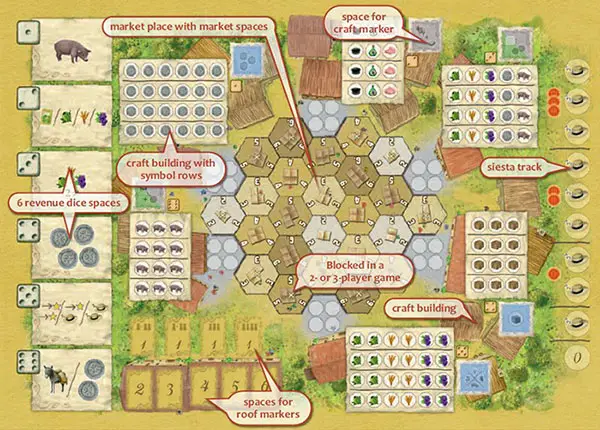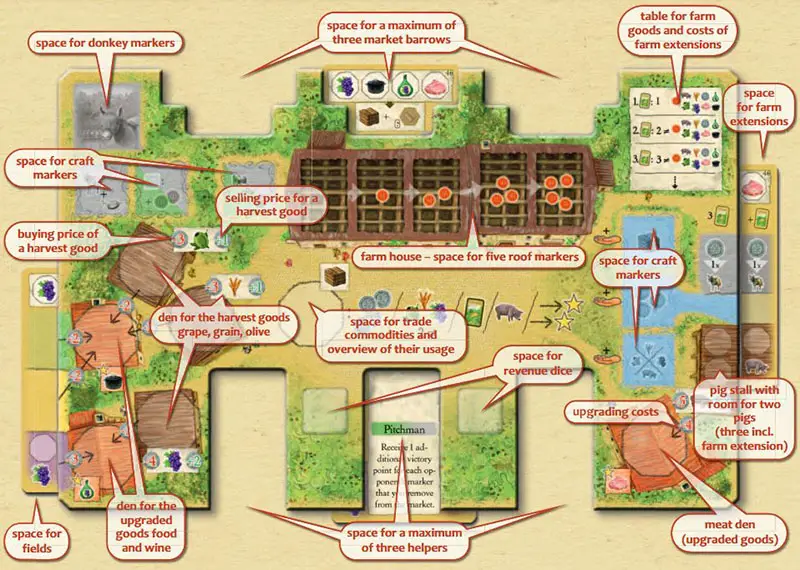
Game Board
The center of La Granja's game board depicts Esporles' market place. It consists of hexagonal market spaces, where each space has a number (value) between 2 and 6. Market spaces featuring an "X" cannot be entered in a 2- or 3-player game.
Six craft buildings are located at the edge of the market. Four different rows of symbols (one per player) are assigned to each craft building. Each player may deliver farm goods or trade commodities to each craft building as denoted by the symbols. Craft markers are stacked on their respective spaces next to the symbol rows.
Revenue spaces are located on the left side of the game board (with dice depicting values from 1 to 6). Spaces for the roof markers are located at the bot- tom left of the board. The markers for rounds 2 through 6 are stacked in round order as denoted on the board. The roof markers for the current ro- und are displayed individually above these stacks.

The siesta track is located on the right side of the game board. It shows how "rested" players are in a given round, and is used to determine turn order.
Farm Cards
La Granja contains 66 farm cards. During the game, players draw cards into their hands and then play them by tucking them under one of the four sides of their farm.
After playing a card, only the side chosen by the player is "Active" and influences the game. The information on the other three sides of the card is irrelevant for the rest of the game.

- A card played to the left of the farm is a field. A specific harvest good grows on a field - either olives, grain, or grapes.
- A card played to one of the three notches at the top of the farm is a market barrow.
- A card played to the right of the farm is a farm extension.
- A card played to one of the three notches at the bottom of the farm is a helper with special abilities.

Revenue Dice
There are nine dice in the game. Depending on the number of play- ers, a certain number of dice is used and assigned to the revenue spaces of the game board.


Player Boards
Each player has a player board which represents his farm. On his farm are six spaces for acquired craft markers, several dens (for harvest goods and upgraded goods), costs for upgrades, purchase and selling prices for resources, a central space for trade commodities, a pig stall with two spaces, a table denoting the 9 farm goods and the costs for farm extensions (which increases with each extension), a farm house with five spaces for purchased roof markers, a space for played donkey markers, and spaces for the two revenue dice the player will choose each round.
Attention: While the space for trade commodities and dens for harvest goods and upgraded goods may hold any number of player markers, the pig stall only has room for a maximum of two pigs (hence two octagonal spaces).
Farm cards may be placed at the appropriate spots on the four sides of the farm; their usage varies according to their location on the farm. At most three cards may be placed at the top and bottom of the farm - one card in each "notch".
Cards placed to the left and right are partially tucked underneath cards that have already been played so that only the appropriate side of the card is showing. There is no limit to the number of cards in these two locations.
Game Markers
Silver "coins"
Silver is the currency in La Granja. The game contains "coins" with a value of 1 and 3. A player may change three "1" coins against a single "3" coin from the "bank" (or vice versa) during the game. If the rules booklet mentions "1 silver" it means one silver coin of value 1.

Victory Point Markers
When a player has earned victory points, he immediately takes that number of victory point markers from the pool. There are markers with value 1, 3, 5, and 10 victory points. A player may "take change" for their markers at any time (e.g., taking a single marker of value 3 for three markers of value 1).
The players may keep the number of their victory points secret. If the rules booklet mentions "1 victory point", it means one victory point marker of value 1.

Craft Markers
Each craft building in the village has its own specific craft marker. Each player may get one marker at each craft building. The front side of the marker shows its "instant function".

Roof Markers
Each player may purchase one roof marker per round. A roof marker provides its owner a one-time bonus. Players earn victory points for roof markers as shown on the player board immediately upon purchase (starting with the second roof marker).

Donkey Markers
Each player has an identical set of four donkey markers. Players select a donkey marker each round. The marker shows the number of deliveries (depicted by donkeys) and sometimes the number of steps a player advances on the siesta track of the game board (depicted by hats).

Building Order Markers
La Granja contains three building order markers. They are placed on three of the six craft buildings in the village at the start of the game and initially bar access to these craft buildings.

Turn Order Markers
These markers record the player order.

Player Aids
The player aids summarize the sequence of a game round. The opposite side lists the ways players may obtain victory points.

Wooden Components
Player Markers
Each player receives 25 player markers in his color. They represent various items a player owns or have used depending on where they are located on the farm or the game board.

Example: If a player marker is on the trade commodity space, it is a trade commodity; if it is on an olive field, it is an olive; if it is on the village market, it is a market stand, etc.
The 25 markers are the maximum a player can have!
If a player has all 25 markers in use (this rarely happens!), he may remove any one marker from his farm or the game board to use as part of his current action.
The Discs
The player discs are placed on the "0" space on the siesta track on the game board. Player discs may be advanced during a game round.
Explanation Of Terms
The following terms have a special meaning in La Granja:
Harvest goods: There are three kinds of harvest goods - olives, grain, and grapes. They are placed in fields and dens and may be upgraded. All harvest goods taken by a player that were not grown in his fields must be placed in the appropriate dens.
Resources: Olives, grain, grapes and pigs (the traditional porc negre) are the resources in the game. They may be bought, sold, or upgraded.
Upgrade (upgraded goods): Grapes are upgraded to wine, pigs to cured meat, and olives and grain are upgraded to food. An upgrade may cost silver.
Revenue: A player gets revenue via a die. Revenue may be one or more resources, silver, a delivery, one or two free upgrades, one or two steps on the siesta track, and the drawing or playing of a card.
Color Labeling: The four phases of a game turn and its various steps are labeled by color.
- Farm Phase - blue
- Revenue Phase - green
- Scoring Phase - red
Trade commodity:Trade commodities may be returned for resources and actions.

Farm: A player's tableau (plus attached farm cards) represent his farm.
Farm goods: An overriding term that includes the following:
- silver
- victory points
- harvest goods(olive, grain, grape)
- upgraded goods(food, wine, cured meat)
- pigs
At the top right corner of a player's farm there is an overview of the costs for farm extensions and all available farm goods.
Delivery: A donkey symbol represents one delivery. A delivery is defined as moving one good from a field or den (and sometimes a card) to either a craft building in the village or to a market barrow on the player's farm.
Continue Reading

